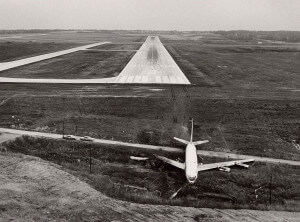Good decisions may still lead to bad things
Things are looking good as the First Officer lines the Boeing 707 up on Runway 27. Weather is good on this November night in Kentucky. VFR conditions and an all but calm wind will make a smooth takeoff. We wouldn’t be here if this was going to go smoothly, would we? The newly-arrived Delta DC-9 just called clear of the runway, another airliner is on the approach, and he advances the throttles.
About half way down the 7800-foot runway and 200 feet before passing behind the Delta aircraft about two-thirds of the way down the runway, the Captain comments to the FO about other plane being so close to the runway. He later testifies, “I could measure it was five, six, seven feet or something of that nature.” Pretty good eye for a measurement made in the dark at about 115 knots. Based on Boeing’s 707 page, the clearance between aircraft would be seven to nine feet, based on his measurement. The Captain and First Officer of the Delta aircraft later testified they were “well clear.” Turns out Delta was stuck in the mud after missing their turn.
Just prior to the “mired” DC-9, the 707 reaches V1 (go/no go speed for takeoff with a single engine failure). The Captain later testifies he announced V1 at 132 knots, but the cockpit voice recorder (CVR) does not confirm this. Right when they pass behind Delta, witnesses see a flash of fire, a loud bang is heard, and the FO feels a movement in the flight controls as the aircraft yaws left. “Good God, I hit him.” he says. Decision time. The TWA Boeing 707 Flying Handbook is pretty clear. Aborts are dangerous and must be executed flawlessly to avoid an overrun. Take off, unless you have an engine failure before reaching V1.
Believing he is at or near V1 and has a damaged aircraft, the FO initiates an abort. The last airspeed he saw was 120 knots, but the Captain did not announce V1. Further, the other plane was very close to the runway and the bang and aircraft yaw happened right when they passed.
The FO closed the throttles, applied brakes, went to full reverse, and called for spoilers, which the Captain deployed. These actions took a bit over 4 seconds after the 1 second bang-to-throttle time. Unfortunately, the correct order of the abort procedure is reduce power, brakes, spoilers, reverse thrust. With the spoilers out killing lift, more weight is on the wheels, which increases the effectiveness of the brakes and shortens the stopping distance.
The Boeing 707 ran off the end of Runway 27L, bounced down a hill, and came to rest 421 feet from the departure end.
TWA Flight 159 crashed at The Greater Cincinnati Airport in Erlanger, Kentucky, November 6, 1967. Aircraft N742TW was destroyed by the runway excursion and subsequent fire. All 7 crew members survived. Of the 29 passengers, 11 sustained injuries. One of the injured passengers died 4 days later.
The bang heard and flame observed by witnesses was later determined to be a momentary compressor stall in the No. 4 engine caused by the jet wash from Delta Flight 379.
The probable cause was determined to be the TWA crew’s inability to successfully abort at the speed when the abort was initiated. The board went on to name the Delta crew’s failure to adequately determine their position prior to notifying the tower they were clear of the runway as a causal factor. One board member dissented, indicating the Delta crew’s actions were the probably cause.
Considerable space in the report was devoted to the actions of the Delta crew and to the inadequacy of the abort procedure, as published in the TWA manual. I have chosen to focus on the abort decision in this post.
Despite the First Officer‘s error in determining the cause of the bang and yaw of the 707, the Board agreed with his decision to abort the takeoff.
I agree the First Officer made the right decision, given his reasonable belief there had been a collision with potentially serious damage to his aircraft. Unless risk to passengers and cabin crew who must help passengers evacuate is greater in an overrun than in the air with a damaged aircraft, abort every time. Risk to airframe and pilots is unimportant.
What would you have done in similar circumstances?
Selected issues also discussed in AAR 68-AK:
- What does “clear of the runway” really mean?
- Assumptions used to calculate V1
Related:
- Air France Flight 007
- TWA Flight 843
——————————————————————————-
NTSB AAR 68-AK
http://www.airdisaster.com/reports/ntsb/AAR68-AK.pdf
Photo obtained via www.StrangeCosmos.com
http://www.strangecosmos.com/content/item/117873.html
SaferAviator exists, in part, to encourage healthy discussion on aviation safety matters. Comments should be respectful and relevant to the current topic. SaferAviator’s detailed Comment Policy can be found on the Legal Matters page.

